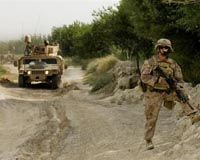| . |  |
. |
Shanghai (AFP) May 5, 2010 The restive regions of Tibet and Xinjiang have for years been thorns in the side of China's ruling Communist Party, but visitors to the World Expo in Shanghai would never know it. The two regions -- rocked in recent years by deadly unrest -- are presented in the giant China pavilion at the just-opened Expo as culturally rich and forward-looking areas steeped in tradition, where ethnic harmony reigns. "Have you seen the movie? It shows the tremendous changes that have happened in Tibet over the last 51 years, since the democratic reforms," says Yang La, a Tibetan hostess dressed in colourful ethnic garb. The first five minutes of the exhibit's promotional film offer a barrage of strikingly beautiful images -- sweeping Tibetan landscapes, the red and white Potala palace in Lhasa, smiling dancers, beaming tourists. The film also shows the world's highest railway linking Tibet to the outside world, laboratories, solar-panelled roofs and spanking-new airports -- all part of Beijing's oft-cited development plan for the region it "liberated" in 1959. But Tibet's Buddhist monks -- who complain of cultural and religious repression -- are nowhere to be seen. Nor is the Dalai Lama, their spiritual leader and Nobel Peace Prize winner who lives in exile in India. Only three monks are seen in the film -- sitting in front of a computer. The display barely makes any reference to religion, with only one photo of a statue of Siddhartha Gautama, the founder of Buddhism, Tibet's principal religion. In a model of a "typical" Tibetan living room, two pictures adorn the walls: one is a collage of photos of Communist leaders Mao Zedong, Deng Xiaoping, Jiang Zemin and the Gate of Heavenly Peace in Beijing's Tiananmen Square. "These are the pictures of the three generations of our leadership," explains Yang. The second photo frame is reserved for a smiling Chinese President Hu Jintao, standing with Tibetans before the Potala Palace -- once the seat of Tibet's Buddhist theocracy headed by the Dalai Lama. Draped around the two frames are hadas, traditional white scarves "to thank China for its concern for the Tibetan people of all ethnic groups", Yang explains. And a reproduction of a painting depicting the "joyous festival of Losar" -- the Tibetan New Year -- shows "how the peoples of Tibet, of various nationalities, are living a happy life", according to the caption. When asked why there are no photos of monks or monasteries, Yang smiles and steps back. She is then called away by her boss to greet other foreign guests. The advocacy group Free Tibet has called for a boycott of the Tibet exhibit, calling it a "crude attempt by the Chinese administration to gloss over the reality of human rights violations and marginalisation" felt by Tibetans. "To visit this parody is to tacitly endorse China's policies in Tibet of arbitrary detention, torture, disappearances, patriotic re-education and the occupation of Tibet," the London-based group said. The group says more than 1,000 Tibetans arrested after the anti-Chinese riots in 2008, which began as protests to mark a failed 1959 uprising against Chinese rule of the region and descended into violence, are still missing. Not far from the display on "Heavenly Tibet" -- described by the Dalai Lama in March as "hell on earth" -- is a sign that proclaims: "Xinjiang, a Harmonious Land". Last year, the far-western region was the scene of deadly ethnic unrest pitting mainly Muslim Uighurs against members of China's dominant Han majority. Nearly 200 people were killed. Expo visitors queue up to learn about Xinjiang -- but they do not learn about recent history. Giant plastic grapevines cascade from the ceiling, dancers in colourful costumes perform, and a film vaunts ethnic harmony. "There are many different ethnic groups in Xinjiang," the film's captions say, adding that agriculture in Xinjiang -- it is indeed a major producer of grapes -- is highly mechanised. Following the dance performance, visitor Liu Ji Yuan -- a Han Chinese from the regional capital Urumqi, where the violence erupted in July last year -- applauds enthusiastically. Liu says the exhibit is "a marvelous place that shows the landscapes of Xinjiang and the character of the people". When asked about the July 2009 unrest, he responds: "What do you know about what happened in Xinjiang last year, huh?" A security guard quickly puts his arm around the man's shoulders, whispers in his ear and escorts him from the building, putting an end to the interview with a curt "Get out" to all.
Share This Article With Planet Earth
Related Links News From Across The Stans
 US military to send 850 troops to train Afghan forces
US military to send 850 troops to train Afghan forcesWashington (AFP) May 4, 2010 The US military has ordered 850 troops to Afghanistan to fill a shortage of trainers for security forces, as European allies needed more time to deploy their instructors, the Pentagon said Tuesday. Defense Secretary Robert Gates approved the deployment of about 150 Marines and an Army battalion for a 90 to 120-day assignment, officials said. "It is designed as a bridging force to try buy ... read more |
|
| The content herein, unless otherwise known to be public domain, are Copyright 1995-2010 - SpaceDaily. AFP and UPI Wire Stories are copyright Agence France-Presse and United Press International. ESA Portal Reports are copyright European Space Agency. All NASA sourced material is public domain. Additional copyrights may apply in whole or part to other bona fide parties. Advertising does not imply endorsement,agreement or approval of any opinions, statements or information provided by SpaceDaily on any Web page published or hosted by SpaceDaily. Privacy Statement |